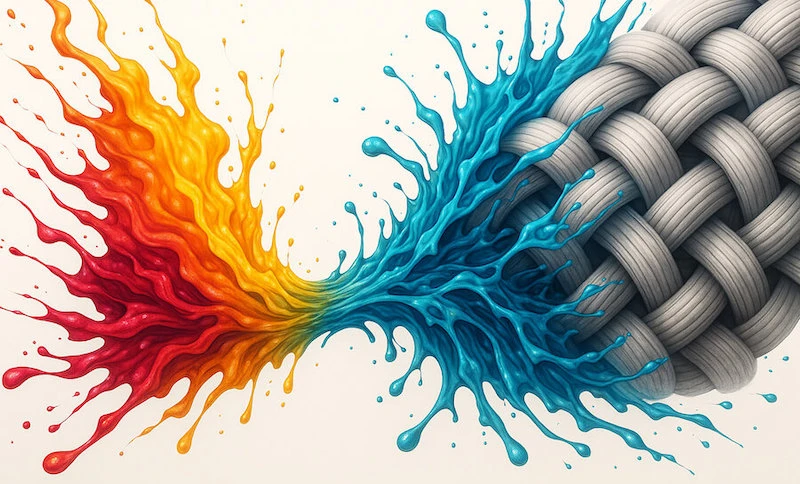Sublimation printing works beautifully on polyester, but have you ever wondered why the ink bonds so well? The answer lies deep in the polymer structure of polyester itself. Understanding this chemistry helps explain why sublimation doesn’t work on cotton and why the right materials are key to vivid, permanent prints.
Polyester is made of long-chain molecules called polymers. These form a tight, repeating structure known as polyethylene terephthalate (PET). When heated, the polymer chains loosen slightly, allowing sublimation dye gases to penetrate. As the material cools, the polymer chains contract again, locking the dye molecules inside the fiber.
Why Polyester’s Molecular Structure Enables Sublimation BondingAt high temperatures (typically 380–400°F), the crystalline regions of polyester temporarily open, allowing dye vapor to penetrate between polymer chains. As the fabric cools, these chains contract, trapping the dye molecules within. This chemical entrapment (not a surface coating) is what makes sublimation prints so durable, washable, and fade-resistant.

This molecular interaction explains why sublimation ink becomes part of the fabric rather than sitting on top like regular ink. The more uniform and high-quality the polyester, the more consistent the color bonding and image sharpness.
Key Takeaways
Polyester’s chemistry enables true sublimation bonding.
Its polymer chains open under heat, allowing dye vapors to embed within the fibers rather than coat the surface.
The PET structure defines print durability.
Once cooled, the polymer network traps dyes permanently, creating wash-proof, fade-resistant designs.
Cotton and natural fibers can’t replicate this.
Without polyester’s thermoplastic flexibility, sublimation inks have nothing to bond with.
Material consistency drives color accuracy.
High-quality polyester with uniform polymer alignment produces sharper, more predictable prints.
How Polyester’s Unique Chemistry Creates a Perfect Bond with Sublimation Ink
Sublimation printing works because polyester’s polymer chemistry allows dye molecules to bond at the molecular level. Polyester is built from polyethylene terephthalate (PET), a thermoplastic polymer with chains that react predictably to heat and pressure. When the fabric reaches around 380–400°F, these polymer chains loosen, creating micro-gaps that let sublimation dye vapor penetrate the fiber surface.
As the polyester cools, the polymer lattice contracts, trapping the dispersed dyes deep inside its molecular structure. This process is known as molecular adhesion or dye infusion, the key reason sublimation prints on polyester are permanent, wash-safe, and fade-resistant. Unlike inks that sit on top of a surface, sublimation dye becomes part of the fiber matrix, not a coating.
In sublimation printing, this polymer-dye interaction must be precise. If the temperature, pressure, or dwell time are inconsistent, the polymer may not fully open, leading to uneven dye absorption. Understanding how PET chemistry, heat activation, and molecular entrapment work together is essential to eliminate ghosting and produce vivid, consistent results.
The PET Polymer Structure That Makes Sublimation Prints Last
The durability of sublimation prints comes from the internal structure of polyethylene terephthalate (PET), the polymer that defines polyester’s strength and stability. PET fibers contain both crystalline and amorphous regions, forming a balanced network that resists heat, tension, and chemical breakdown. During sublimation, the amorphous zones allow dye gases to diffuse, while the crystalline zones provide molecular entrapment that locks color in place once the material cools.
This internal polymer alignment is critical for long-term color retention. Well-structured PET fibers ensure consistent dye fixation, preventing premature fading or washout. When the polymer lattice is uniform, heat distributes evenly through the fabric, enabling controlled dye absorption and sharp edge definition.
If the PET structure is irregular, for example, due to uneven crystallinity or low-quality fiber formation, heat can travel inconsistently across the surface. This creates patchy sublimation, color bleed, or subtle ghosting halos where dye diffusion varies from one area to another. The thermal stability of the PET matrix ultimately determines not just how vivid a sublimation print looks, but how well it maintains clarity and alignment over time.
Why Cotton and Other Natural Fibers Can’t Hold Sublimation Color
Sublimation printing depends on bonding dye vapor within the fiber structure, but cotton and other natural fibers lack the molecular features needed for that reaction. Cotton is made of cellulose fibers, which are hydrophilic. They attract water but don’t respond to heat the same way hydrophobic, thermoplastic materials like polyester do. Because cellulose doesn’t soften or open under high temperature, dye gases can’t penetrate the fiber, only sit briefly on the surface.
To make sublimation work on cotton, manufacturers sometimes add a surface coating or polyester-based pre-treatment. These layers create a temporary film that allows color transfer, but the result lacks the fiber infusion that makes polyester prints permanent. Over time, coatings can break down.
Consistent Polyester Fibers Produce More Accurate Colors and Sharper Images
The precision of a sublimation print depends heavily on fiber consistency and weave uniformity. When polyester threads are evenly aligned, dye gases diffuse predictably, producing balanced color density and sharp image definition. Any irregularities, such as uneven weave tension, fiber contamination, or mixed-quality polyester, disrupt dye saturation control.
| 💡 What’s the difference between PET structure and consistent polyester fibers?The PET structure is polyester’s chemical makeup that reacts to heat and locks dye into the fabric. Consistent fibers describe how evenly the fabric is woven. PET affects how well the ink bonds; fiber consistency affects how sharp and accurate the print looks. |
High-grade polyester with uniform fiber alignment ensures accurate color reproduction and print clarity because every strand reacts to heat and pressure the same way. Maintaining this consistency through fabric quality control minimizes ink misalignment and guarantees clean, vivid results across production runs.
Related Topics
